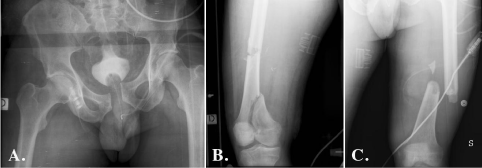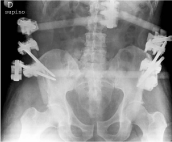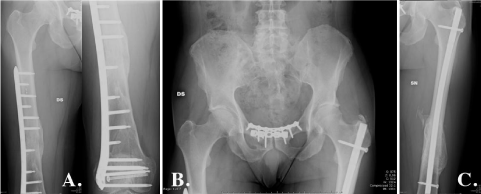
Special Article - Damage Control Surgery & Case Reports
Austin J Trauma Treat. 2016; 3(1): 1010.
Bilateral Floating Hip with Bifocal Fractures of the Femur – A Case Report
Spagnolo R1, Luceri F2*, Sala F3 and Capitani P3
1Department of Orthopaedic Surgery and Traumatology, Romano di Lombardia Hospital, Italy
2Sport Traumatology and Arthroscopic Unit, IRCCS Galeazzi Orthopaedic Institute, Italy
3Department of Orthopaedic Surgery and Traumatology, Niguarda Hospital, Italy
*Corresponding author: Luceri Francesco, Sport Traumatology and Arthroscopic Unit, IRCCS Galeazzi Orthopaedic Institute, Milan, Italy
Received: April 26, 2016; Accepted: May 12, 2016; Published: May 13 , 2016
Abstract
Patients with bilateral femoral fractures have a significantly higher risk of death, ARDS, and associated injuries than patients with unilateral femoral fractures. This increase in mortality is more closely related to associated injuries and physiological parameters. The presence of bilateral femoral fractures should alert the clinician to the likelihood of associated injuries, a higher Injury Severity Score, and the potential for a more serious prognosis. Both pelvic fractures and femoral shaft fractures are caused by high-energy injuries. When unstable pelvic and femoral shaft fractures occur concomitantly, the optimal treatment method is controversial. The aim of this study was to establish a reasonable principle for treating them in simultaneous occurrences of ipsilateral floating hip associated with bifocal femoral fractures and contralateral femoral shaft fractures that have not been reported in literature.
Keywords: Floating hip; Femoral fractures; Pelvis fracture; Bifocal; Bilateral; Skeletal traction
Introduction
Patients with bilateral femoral fractures have a significantly higher risk of death, ARDS, and associated injuries than patients with unilateral femoral fractures. This increase in mortality is more closely related to associated injuries and physiological parameters. The presence of bilateral femoral fractures should alert the clinician to the likelihood of associated injuries, a higher Injury Severity Score, and the potential for a more serious prognosis [1-4]. Both pelvic fractures and femoral shaft fractures are caused by high-energy injuries. When unstable pelvic and femoral shaft fractures occur concomitantly, the optimal treatment method is controversial. The aim of this study was to establish a reasonable principle for treating such complicated injuries. Simultaneous occurrences of ipsilateral floating hip associated with bifocal femoral fractures and contralateral femoral shaft fractures have not been reported in literature. Pelvis fractures were classified according to the Young-Burgess classification [5] and long bones fractures to the AO classification [6]. The floating hip was defined by Liebergall who described two types: Type A, acetabular fracture associated with a femoral fracture, and Type B, pelvis fracture associated with a femoral fracture [7,8].
Case Report
A 57 year-old man, due to a motorcycle accident, was transported unconscious to our hospital by rescue helicopter. He arrived two hours after the trauma in our Emergency Room and was admitted as a major trauma according to the American College of Surgeon Pre Hospital Triage Criteria (ISS =17).
The patient had a deformity of both lower extremities at femoral level. Plain radiographs performed immediately showed a diastasis of symphysis pubis, diaphyseal fracture of left femur (AO 32B2) and bifocal fractures of right femur, one diaphyseal (AO 32A3) and the other intrarticular of the distal epiphysis (AO 33B2) (Figure 1).

Figure 1: X-rays in the Emergency Room. A. Pelvis B. Right femur C. Left
femur.
The patient was hemodynamically unstable and, therefore, he was intubated and received allogeneic blood transfusions. Then a total body CT scan was performed to find other hidden injuries and to better classify the fractures.
In addition to the diastasis of symphysis pubis, an instability of the right sacroiliac joint was found and classified as a Young-Burgess Type III and Liebergall type B [5,7,8].
One hour after the admission, in the Operating Room (OR), a pelvis external fixation was applied to stabilize the sacroiliac joints, with the reduction of the symphysis pubis. In addition to this, both lower limbs were treated with skeletal traction (Figure 2).

Figure 2: Pelvis stabilization with the external fixation.

Figure 3: X-rays six years after trauma with a radiographic healing of the
fractures.
The patient was admitted in the Intensive Care Unit (ICU) to monitor the hemodynamic responses after allogeneic blood transfusions (1000 cc).
Five days after trauma, the definitive synthesis of the femoral fractures was performed. The single fracture of the left femur was treated with ante grade nailing. The bifocal fractures of the right femur were both stabilized with a Less Invasive Stabilization System (LISS) plate after an accurate reduction of the fragments. After other ten days, the pelvis external fixator was removed and the symphysis pubis was fixed with double plates, one anterior and the other superior, after a closed reduction of the right sacroiliac joint. The mobilization of the lower limbs with a physical therapist was granted immediately and nineteen days after trauma the patient managed to sit down on the chair.
The patient remained hospitalized in the ICU to manage a pulmonary embolism which started seven days after last surgery with dyspnea and diagnosed with a chest-CT: a treatment with intravenous Unfractionated Heparin (UH) was started.
Twenty-four days after trauma he was discharged from the Intensive Care Unit with good clinical condition. Nine days later, he was discharged from the hospital with his therapy switched from UH to LMWH.
Post-operative treatment
Lower limbs were maintained unloaded for six weeks, after which he was allowed to load on the right leg. On the left lower limb, he started to partially load the weight after three months. Five months after trauma he walked without crutches with a Visual Analogue Scale (VAS) of 0. He returned to work ten months after trauma. Six years later he removed the femoral fixation devices. At the final clinical evaluation both hips showed a full ROM without pain.
Discussion
Pelvic, or acetabular, fracture associated with a femur fracture is defined as “floating hip” and it is very uncommon. [2] Sciatic nerve injuries are more common in these fractures [3].
Treatment of floating hip is controversial and not yet well defined. The surgical treatment changes according to the floating hip type. In Liebergall Type A, the first fracture that must be treated is the femoral one. In Liebergall Type B, the fixation of the pelvis fracture should be done first and the subsequent stabilization of diaphyseal fractures must be postponed until the patient is hemodynamically stable [9,10].
Isolated femoral shaft fractures have up to 9% mortality [1].
In polytrauma patients with pelvic trauma and evidence of acute bleeding it is very important to stop bleeding. When a pelvic fracture is diagnosed, the early application of temporary pelvic closure, when needed, should always be considered [4]. Bilateral femoral shaft fractures are reported to increase the risk of systemic complications and mortality [11]. It has been reported that the application of external fixation in Damage Control Orthopedics (DCO) had similar results to skeletal traction in the serious polytrauma patient [12]. In severely injured patients, Skeletal Traction had lower rate of sepsis and a shorter Lenght of Stay than External Fixation [3]. Early definitive stabilization of fractures is recommended to reduce complications (pulmonary problems, Deep Venous Thrombosis, etc.) [3,13].
The clinical evaluation of the patient at the follow-up was defined excellent, considering the pain, motility and walking. The result is defined excellent when the patient feels no pain, good with mild pain that not limit deambulation, moderate with persistent pain and intermittent claudication, bad with severe pain and severe limitation of deambulation [14].
Conclusion
When we are faced with a floating hip the ideal treatment is controversial. The main aim is to stabilize the fractures to reduce, and stop bleeding and thus stabilize the hemodynamic status. This approach must be even more so maintained in the presence of bilateral femoral fractures and floating hip. A definitive stabilization must be done as soon as clinical conditions allow it, respecting DCO criteria.
References
- Wu CL, Tseng IC, Huang JW, Yu YH, Su CY, Wu CC. Unstable pelvic fractures associated with femoral shaft fractures: a retrospective analysis. Biomed J. 2013; 36: 77-83.
- Tiedeken NC, Saldanha V, Handal J, Raphael J. The irreducible floating hip: a unique presentation of a rare injury. J Surg Case Rep. 2013; 2013.
- Scannell BP, Waldrop NE, Sasser HC, Sing RF, Bosse MJ. Skeletal traction versus external fixation in the initial temporization of femoral shaft fractures in severely injured patients. J Trauma. 2010; 68: 633-640.
- Chiara O, Cimbanassi S, Castelli F, Spagnolo R, Girotti P, Pizzilli G, et al. Protocol-driven approach of bleeding abdominal and pelvic trauma. World J Emerg Surg. 2006; 1: 17.
- Young JW, Burgess AR, Brumback RJ, Poka A. Pelvic fractures: value of plain radiography in early assessment and management. Radiology. 1986; 160: 445-451.
- Muller ME, Nazarian S, Koch P, Schatzker J. The comprehensive classification of fractures of long bones. Berlin: Springer. 1996.
- Liebergall M, Lowe J, Whitelaw GP, Wetzler MJ, Segal D. The floating hip. Ipsilateral pelvic and femoral fractures. J Bone Joint Surg Br. 1992; 74: 93-100.
- Liebergall M, Mosheiff R, Safran O, Peyser A, Segal D. The floating hip injury: patterns of injury. Injury. 2002; 33: 717-722.
- Burd TA, Hughes MS, Anglen JO. The floating hip: complications and outcomes. J Trauma. 2008; 64: 442-448.
- Suzuki T, Shindo M, Soma K. The floating hip injury: which should we fix first? Eur J Orthop Surg Traumatol. 2006; 16: 214-218.
- Kobbe P, Micansky F, Lichte P, Sellei RM, Pfeifer R, Dombroski D, et al. Increased morbidity and mortality after bilateral femoral shaft fractures: myth or reality in the era of damage control? Injury. 2013; 44: 221-225.
- Caba-Doussoux P, Leon-Baltasar JL, Garcia-Fuentes C, Resines-Erasun C. Damage control orthopaedics in severe polytrauma with femur fracture. Injury. 2012; 43 Suppl 2: S42-46.
- Nahm NJ, Como JJ, Wilber JH, Vallier HA. Early appropriate care: definitive stabilization of femoral fractures within 24 hours of injury is safe in most patients with multiple injuries. J Trauma. 2011; 71: 175-185.
- Rommens PM, Hessmann MH. Staged reconstruction of pelvic ring disruption: differences in morbidity, mortality, radiologic results, and functional outcomes between B1, B2/B3, and C-type lesions. J Orthop Trauma. 2002; 16: 92-98.